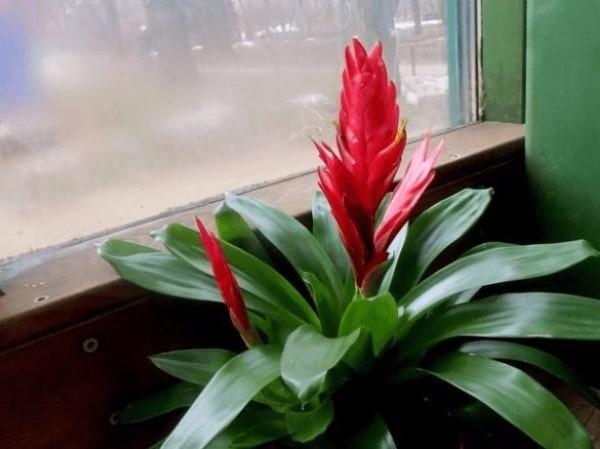Features of care for vriezia
 All plants from the bromeliad family in nature are considered parasitic crops, they grow on tree trunks, clinging to the bark with their roots. However, due to their spectacular appearance, bromeliads have found their place in indoor floriculture. Take, for example, Vriezia with its lush rosette of hard leaves and original flowering, both in shape and in bright color. In principle, this flower is not very capricious, but if you decide to have it, you should definitely take into account the natural habitat and the characteristic features of the development of plants of this family.
All plants from the bromeliad family in nature are considered parasitic crops, they grow on tree trunks, clinging to the bark with their roots. However, due to their spectacular appearance, bromeliads have found their place in indoor floriculture. Take, for example, Vriezia with its lush rosette of hard leaves and original flowering, both in shape and in bright color. In principle, this flower is not very capricious, but if you decide to have it, you should definitely take into account the natural habitat and the characteristic features of the development of plants of this family.
Why does epiphyte need soil?
Unlike other indoor flowers, which draw food directly from the ground using the root system, vriese it does not need soil as such. In addition, her roots are very small and serve for direct "collection" of moisture directly from the air.
The soil in the pot is needed exclusively to fix the flower in an upright position. In this case, he receives moisture from the leaves when spraying.
If possible, you can do without a flowerpot with soil, and fix the vriezia on a tree in the winter garden, but just remember to spray the roots and leaves. These will be ideal living conditions for her, as close as possible to natural ones.
In the case when the flower will still grow in a pot, it is better to fill it with orchid substrate. The soil from the garden is too heavy for Vriezia - there it will quickly rot.
How to water Vriezia?
Like all epiphytes, vriezia receives moisture through the leaves, so spraying is not only desirable for it, but also replaces the watering itself in the pot. Their frequency depends on the season:
- in summer, when it is hot and dry weather, the bush is sprayed daily, or even several times a day;
- in spring and autumn - in a day or two;
- in winter, when the radiators are operating, the frequency of spraying depends on the air temperature: the warmer it is in the room, the more often the leaves need to be moistened.
In addition to spraying, sometimes a small amount of vriezia should be watered in the center of the outlet - there it collects moisture in nature.
What to do after flowering ends?
Unfortunately, the beginning of blooming of Vriezia also means the beginning of the end of its life cycle. When a peduncle with brightly colored leaves shoots from the center of the rosette, the flower begins to prepare for withering away. Of course, this does not happen immediately: first, nondescript small flowers will appear from the bracts, then they will wither, but the peduncle itself will stand in the outlet for a long time (from 3 to 6 months).
During this time, the vriezia will form the children. When the peduncle is dry, it can be removed. Now the outlet itself will begin to fade, but the children will grow.
After the children form their own roots, they are seated in separate flowerpots, and the mother's flower is thrown away - it has already served its purpose.